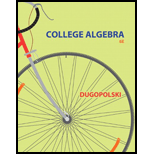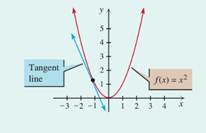
For Individual or Group Explorations
Tangent Lines
 A line tangent to a parabola must intersect the parabola at exactly one point, as shown in the accompanying figure. Of course, it is impossible to draw a graph that really looks like there is one point of intersection. However, if we find a tangent line algebraically, then we can he sure that it intersects only once.
A line tangent to a parabola must intersect the parabola at exactly one point, as shown in the accompanying figure. Of course, it is impossible to draw a graph that really looks like there is one point of intersection. However, if we find a tangent line algebraically, then we can he sure that it intersects only once.
a) Consider y = x2 and the point (3, 9). If y – 9 = m(x – 3) is tangent to the parabola at (3, 9), then the system
y = x2
y – 9 = m(x – 3)
must have exactly one solution. For what value of m docs the system have exactly one solution?
b) Graph the parabola and the tangent line found in part (a) on a graphing calculator and then use the intersect feature of the calculator to find the point of intersection.
c) There is another line that intersects y = x2 at (3, 9) and only at (3, 9). What is it? Why did it not appear in part (a)?
d) Use the same reasoning as used in part (a) to find the slope of the tangent line to y = x2 at (x1, y1).
e) Use the result of part (d) to find the equation of the tangent line to y = x2 at (–2.5, 6.25).

Want to see the full answer?
Check out a sample textbook solution
Chapter 7 Solutions
College Algebra Plus New Mymathlab With Pearson Etext Access Card
Additional Math Textbook Solutions
Pathways To Math Literacy (looseleaf)
Elementary & Intermediate Algebra
Elementary Statistics (13th Edition)
Elementary Statistics ( 3rd International Edition ) Isbn:9781260092561
College Algebra (Collegiate Math)
University Calculus: Early Transcendentals (4th Edition)
- Solve the equation. Write the smaller answer first. 2 (x-6)² = 36 x = Α x = Previous Page Next Pagearrow_forwardWrite a quadratic equation in factored form that has solutions of x = 2 and x = = -3/5 ○ a) (x-2)(5x + 3) = 0 ○ b) (x + 2)(3x-5) = 0 O c) (x + 2)(5x -3) = 0 ○ d) (x-2)(3x + 5) = 0arrow_forwardA vacant lot is being converted into a community garden. The garden and a walkway around its perimeter have an area of 690 square feet. Find the width of the walkway (x) if the garden measures 14 feet wide by 18 feet long. Write answer to 2 decimal places. (Write the number without units). Hint: add 2x to each of the garden dimensions of 14 x 18 feet to get the total area for the length multiplied by width.arrow_forward
- Solve the rational equation 14 1 + x-6 x x-7 x-7 ○ a) x = 1, x = 8 ○ b) x = 1 ○ c) x = 7 ○ d) x = 1, x = 7arrow_forwardSolve the absolute inequality | x + 5 > 3 ○ a) (-∞, -8] U[-2, ∞0) ☐ b) (-8, -2) c) (-2, ∞0) ○ d) (-∞, - 8) U(-2, ∞0)arrow_forward1) Listen Describe the error in the problem X 3 X x 3 - 2 = 25x = 0 25x 25 x = ±5arrow_forward
- A falling object travels a distance given by the formula d = 6t + 7t² where d is in feet and t is the time in seconds. How many seconds will it take for the object to travel 115 feet? Round answer to 2 decimal places. (Write the number, not the units). Your Answer:arrow_forwardListen Solve the quadratic equation. Write the smaller answer first. 2 Xx - 5x = 24 x = Α x =arrow_forwardSolve the absolute equation |2x = 4| = 10 ○ a) x = -7, x = 3 ○ b) x = -2, x = 6 ○ c) x = -3, x = 7 ○ d) x = 7arrow_forward
 Elementary Geometry For College Students, 7eGeometryISBN:9781337614085Author:Alexander, Daniel C.; Koeberlein, Geralyn M.Publisher:Cengage,Algebra & Trigonometry with Analytic GeometryAlgebraISBN:9781133382119Author:SwokowskiPublisher:Cengage
Elementary Geometry For College Students, 7eGeometryISBN:9781337614085Author:Alexander, Daniel C.; Koeberlein, Geralyn M.Publisher:Cengage,Algebra & Trigonometry with Analytic GeometryAlgebraISBN:9781133382119Author:SwokowskiPublisher:Cengage Trigonometry (MindTap Course List)TrigonometryISBN:9781305652224Author:Charles P. McKeague, Mark D. TurnerPublisher:Cengage Learning
Trigonometry (MindTap Course List)TrigonometryISBN:9781305652224Author:Charles P. McKeague, Mark D. TurnerPublisher:Cengage Learning Mathematics For Machine TechnologyAdvanced MathISBN:9781337798310Author:Peterson, John.Publisher:Cengage Learning,
Mathematics For Machine TechnologyAdvanced MathISBN:9781337798310Author:Peterson, John.Publisher:Cengage Learning, College Algebra (MindTap Course List)AlgebraISBN:9781305652231Author:R. David Gustafson, Jeff HughesPublisher:Cengage Learning
College Algebra (MindTap Course List)AlgebraISBN:9781305652231Author:R. David Gustafson, Jeff HughesPublisher:Cengage Learning Trigonometry (MindTap Course List)TrigonometryISBN:9781337278461Author:Ron LarsonPublisher:Cengage Learning
Trigonometry (MindTap Course List)TrigonometryISBN:9781337278461Author:Ron LarsonPublisher:Cengage Learning





